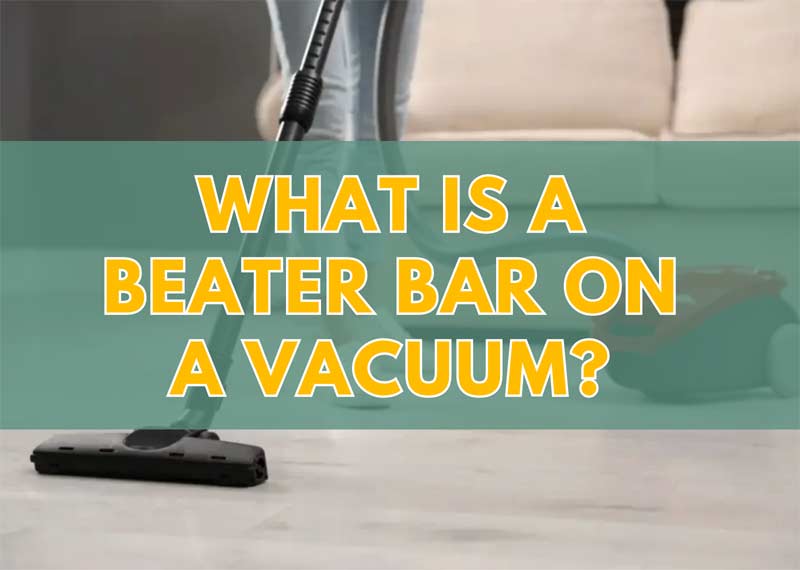A beater bar on a vacuum is a rotating brush that helps to agitate and loosen dirt and debris from carpet fibers, making it easier for the vacuum to suction it up. When vacuuming carpets, it’s essential to have a high-quality beater bar, as it can make a significant difference in the cleanliness of your floors. The rotating brush works by sweeping through the carpet fibers, dislodging debris that may be stuck deep in the pile. This ensures that the vacuum can suction up as much dirt and dust as possible, leaving your carpets fresh and clean. Beater bars come in a range of styles, including those with bristles of varying lengths, and those made from materials like nylon and other synthetic fibers. Regardless of the material, a high-quality beater bar can be a valuable tool in keeping your carpets in top condition. In this article we will know what is a beater bar on a vacuum and other information.

The History Of Beater Bar On A Vacuum Cleaner
Vacuum cleaners have undergone numerous changes throughout their evolution, including the addition of a beater bar. Here’s a brief history of the beater bar on vacuums:
Early Versions Of Vacuum Cleaners And Their Beater Bars
- Early vacuum cleaners didn’t have a beater bar. Instead, the vacuum’s suction alone was used to clean floors.
- The first beater bar was invented in 1911 by hubert cecil booth, the man credited as the inventor of the vacuum cleaner.
- The early beater bar was comprised of a rotating brush within a vacuum head that loosened debris from carpets, allowing easier suction removal.
- These vacuum cleaners were heavy, expensive, and mostly used by wealthy families or businesses.
- The beater bar technology remained unaltered for several decades.
The Evolution Of Beater Bar Technology
- Vacuum beater bars subsequently received multiple improvements, including increasing the number of brushes on the bar, adding adjustable height controls, and even belts to facilitate rotation.
- In the 1960s, a new “power nozzle” technology was developed, which utilized a motorized beater bar for carpets.
- Later came the invention of the “self-adjusting cleaner heads” technology employed in dyson vacuum cleaners, which automatically adjusts the height of the beater bar according to floor types.
- Modern beater bar-covered vacuum cleaners have become more efficient and versatile in tackling different floor types and sizes.
How Beater Bars Became An Essential Cleaning Tool
- With each update in beater bar technology, it has become impossible to imagine a vacuum cleaner without a beater bar.
- The beater bar is now an integral tool in deep cleaning carpets and removing debris from multiple floor types.
- The continuous evolution of beater bars facilitated the creation of modern vacuum cleaners that are more efficient, versatile, and lightweight.
- The beater bar now plays a crucial role in ensuring a clean, healthy environment in homes and businesses around the world.
How A Beater Bar Works: An In-Depth Explanation
Have you ever wondered what a beater bar on a vacuum is and how it works? A beater bar is a component found in most vacuums that does an excellent job of assaulting dirt and debris from carpets or upholstery. It is essential to understand the different parts of the beater bar, the mechanisms behind how it works, and how it improves vacuum cleaning.
Anatomical Parts Of A Beater Bar
Understanding the anatomy of a beater bar can help us grasp how it functions in a vacuum cleaner. Some of the essential parts include:
- Brush roll: This is the rotating part of the beater bar that comes in contact with carpets or upholstery. The brush roll has bristles that agitate dirt and debris to loosen them from fibres.
- Belt: The belt connects the brush roll with the vacuum’s motor to provide power, enabling the brush roll to rotate when the vacuum is switched on.
- End caps: These are the plastic or metal covers that hold the brush roll in place and allow it to spin inside the housing.
Mechanisms Of A Beater Bar
A beater bar uses several mechanisms to complete its cleaning process and provide an impressive cleaning result.
- Rotating brush: The rotating brush moves in a back-and-forth motion, reaching deep into the fibers of carpets or upholstery to loosen dirt, dust, and debris.
- Bristles: The bristles on the brush roll rotate, sweeping dirt, and debris towards the front of the beater bar, where they are sucked up by the vacuum.
- The belt: The belt provides power to the brush roll, which enables it to move and loosen debris, making it easier for the vacuum’s suction power to suck up the dirt.
How A Beater Bar Improves Vacuum Cleaning
A beater bar is a vital component of effective vacuum cleaning. Here are some of the ways in which beater bars improve vacuum cleaning:
- Agitation: Beater bars agitate the surface being cleaned, effectively loosening dirt and debris, making it easier for the vacuum’s suction power to collect them.
- Debris removal: The brush roll’s bristles make it easier to remove dirt and debris from the fibers of carpets and upholstery, providing a deep clean.
- Time-saving: Beater bars save time while cleaning by making the process more efficient. It is an economical way to keep your floors and upholstery looking their best.
Understanding how a beater bar works is essential to appreciate its significance in effective vacuum cleaning. It is a complex component that uses various mechanisms to provide a deep clean that vacuums alone cannot deliver. With its unique design, the beater bar is a game-changer that makes cleaning carpets and upholstery a breeze, leaving your floors and furniture looking their best.
The Advantages Of Using A Beater Bar On A Vacuum Cleaner
Carpeted floors can be difficult to clean without the proper tools. A beater bar is a component of vacuum cleaners designed to improve the efficiency of carpet cleaning. The following are the advantages of using a beater bar on a vacuum cleaner:
Improved Cleaning Efficiency Of Carpeted Surfaces
- A beater bar can effectively remove dirt, dust, and debris from carpets, resulting in improved cleaning efficiency.
- It uses a rotating brush to loosen dirt and grime from the fibers of carpets, making it easier for the vacuum to pick them up.
- This helps to leave your carpets looking and feeling cleaner.
Confidence In Cleaning Pet Hair From Carpets
- Pet hair can be stubborn to remove from carpets, but a beater bar can do the job effectively.
- The rotating brush of the beater bar can efficiently pick up pet hair from the carpet fibers, leaving your floors clean and hair-free.
- This helps you to feel confident in your ability to keep your carpets free of pet hair.
Deep Cleaning Of High-Traffic Areas
- Areas of your carpet that experience high traffic can be difficult to clean, but a beater bar is up to the task.
- Its powerful brush can deeply clean areas where dirt, debris, and allergens tend to accumulate.
- This helps to ensure that the high-traffic areas of your carpets are clean and free of harmful elements.
Maintaining And Prolonging The Lifespan Of Carpets
- Carpets can be a significant investment, and it is essential to take care of them properly.
- Regular use of a beater bar on your vacuum cleaner can help to prolong the lifespan of your carpets.
- This is because it effectively removes dirt, debris, and allergens, preventing them from accumulating and damaging the fibers of the carpet.
Using a beater bar on your vacuum cleaner has numerous advantages. It improves the cleaning efficiency of carpeted surfaces, helps to clean pet hair from carpets, deep cleans high-traffic areas, and helps to maintain and prolong the lifespan of carpets.
Investing in a vacuum cleaner with a beater bar is a wise choice that can help you keep your carpets clean and looking their best for years to come.
How To Choose The Right Beater Bar For Your Vacuum Cleaner
Factors To Consider When Selecting A Suitable Beater Bar
When it comes to selecting a suitable beater bar for your vacuum cleaner, you need to consider a variety of factors. Here are some of the most essential factors you should keep in mind:
- Material: Beater bars can be made of different materials, including steel, aluminum, or plastic. The material you choose will depend on the type of flooring you have in your home.
- Length: The length of the beater bar is another important factor to consider. A longer beater bar is suitable for larger rooms, while a shorter one is better for smaller spaces.
- Stiffness: The stiffness of the beater bar is also important. A stiffer bar is better for carpets, while a softer one is ideal for bare floors.
Common Types Of Beater Bars And Their Applications
There are different types of beater bars that you can choose from, depending on the type of vacuum cleaner you have and the flooring surface of your home. Here are some of the most common types of beater bars and their applications:
- Standard beater bar: This is the most common type of beater bar, and it is suitable for carpets and rugs.
- Air-driven beater bar: This type of beater bar is powered by air flow, and it is ideal for cleaning pet hair from carpets and upholstery. It is also suitable for bare floors.
- Motorized beater bar: This type of beater bar is powered by a motor, and it is the most powerful of all beater bars. It is ideal for deep cleaning carpets and rugs.
Maintenance And Repair Of Beater Bars For Extended Use
To keep your beater bar in good condition and extend its lifespan, you need to perform regular maintenance and repair. Here are some tips to help you:
- Clean the beater bar regularly: Use a wire brush or a soft cloth to remove any hair or debris that may have accumulated on the bar.
- Check the belt: If the beater bar is not spinning, you may need to replace the belt. Check the belt periodically to ensure that it is in good condition.
- Lubricate moving parts: Apply lubricant to the moving parts of the beater bar to reduce friction and ensure smooth operation.
- Replace worn parts: If any parts of the beater bar are worn out, such as the brush bristles or the bearings, you may need to replace them to ensure that the bar is functioning properly.
By following these tips, you can ensure that your beater bar is always in good working condition and that your vacuum cleaner is performing at its best.
Conclusion
After reading this article, we hope you have a better understanding of the importance of a beater bar on your vacuum. As you have learned, it is an essential component that helps with the removal of dirt and debris from your floors and carpets. The beater bar works by agitating the fibers of your carpets, loosening and removing any dirt or debris that is embedded deep inside. It is important to note that not all beater bars are created equal, so it’s essential to choose a vacuum with a high-quality one. Remember, a well-functioning beater bar can make all the difference in the cleanliness of your home. Regular maintenance of your vacuum, including proper cleaning and maintenance of the beater bar, will extend the life of your vacuum, ensure peak performance, and provide a cleaner, healthier home for you and your family.
Frequently Asked Questions
A beater bar is a rotating brush that sits at the bottom of a vacuum cleaner. It is designed to agitate carpets and rugs to loosen dirt, making it easier for the vacuum to suck up debris.
The beater bar spins at high speeds and hits carpet fibers, causing them to vibrate and release dirt. The vacuum then sucks up the released debris. This agitation ability makes a beater bar particularly effective on carpets or other soft surfaces.
No, not all vacuums have beater bars. Some vacuums have a straight suction mechanism that sucks up debris without the use of a beater bar. Beater bars are mostly found on upright vacuums and some canister vacuums.
Yes, beater bars can cause damage to hardwood floors, particularly if they are old or finished improperly. When used on hardwood flooring, the beater bar can scratch or mar the surface. It is best to turn off the beater bar or use a vacuum that has a setting specifically for hardwood floors.
You should clean your beater bar regularly to prevent clogs and maintain its effectiveness. It is recommended to clean it every one or two uses, depending on how heavily soiled your floors are. You should also check it occasionally for any damage or signs of wear and tear.
Yes, most beater bars can be replaced if they become damaged or worn out. You should check your vacuum’s documentation or contact the manufacturer to find the correct replacement part. Be sure to follow the manufacturer’s instructions when installing a new beater bar.

Hi there! I’m Tareq, the vacuum aficionado behind the reviews on this site. With a passion for spotless spaces and a knack for dissecting vacuum features, I’m here to simplify your hunt for the perfect cleaning companion. Let’s make cleaning a breeze together!

